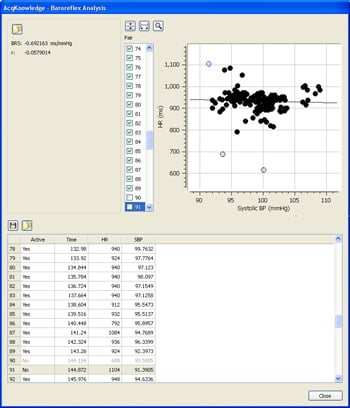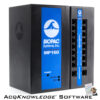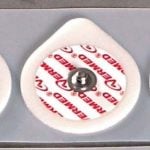The Baroreflex Sensitivity (BRS) analysis license for AcqKnowledge provides two standard algorithms for deriving BRS from measures of blood pressure and ECG, the slope method and the sequence method. Baroreflex Sensitivity (BRS) measures the relationship between blood pressure and heart rate. The body regulates blood pressure to ensure proper blood flow to organs underneath different conditions, e.g. supine to standing. Baroreflex sensitivity is a measure of how quickly the blood pressure system can compensate for changes in conditions. Variations in baroreflex sensitivity are useful as a comparative measure between subjects and for assessing various external impacts.
Slope method:
This method operates over user selected regions of data or the entire file. The routine identifies each ECG cycle and marks the components within the cycle (P,Q,R,S & T) and also locates and marks the systolic and diastolic points of the blood pressure signal. Systolic blood pressure values are plotted against the heart rate values in an interactive X/Y display that includes a table of values for each cycle. When a particular point is selected in the X/Y plot, the display highlights the data in the time series chart display. Data points can be turned off and on by selecting the X/Y points, or identifying them in the data table, and the slope of the best linear regression fit is updated to reflect the changes. The BRS value and goodness of fit value are also displayed and updated as data points are turned on and off.

Sequence method:
This method operates over the entire file or within focus areas. The routine identifies each ECG cycle and marks the components within the cycle (P, Q, R, S & T) and also locates and marks the systolic and diastolic points of the blood pressure signal. There is an option for displaying the R-R values and systolic blood pressure values as new channels so that you can quickly identify outliers or noise in the raw data. The primary dialog includes settings for the minimum number of consecutive increasing or decreasing cycles and the minimum rate of change for heart rate (msec) and systolic blood pressure (mmHg) before a sequence is initiated. The results of the analysis are displayed in the Journal or spreadsheet file.
The MP160 System offers:
- Ethernet-ready data acquisition and analysis – ships with USB 2.0 to Ethernet Adapter, 10/100 Mbps – ETHUSB
- AcqKnowledge current release software
- Record multiple channels with differing sample rates
- Record at speeds up to 400 kHz (aggregate)
- Record from multiple MP160s with the Linked Acquisition feature in AcqKnowledge
Place one or more MP160 Systems in a local area network (LAN). Use any PC in the LAN to record from any MP160 system in the network.
Product Type
Product Options
Platform Options
Ready-to-Run Discovery
Includes all hardware, software, cables & guides needed to get started. Flexible, modular system is easily tailored to specific research. Multiple interfaces & 3rd-party application support.
Monitor, record and analyze changes in baroreflex sensitivity
Slope method operates over user selected regions of data or the entire file. Sequence method operates over the entire file or within focus areas.
Intuitive, Elegant AcqKnowledge Software
Powerful automated analysis for ECG, HRV, EEG, EMG, EGG, and many more. Instantly & easily view, measure, analyze, and transform data.









Stay Connected